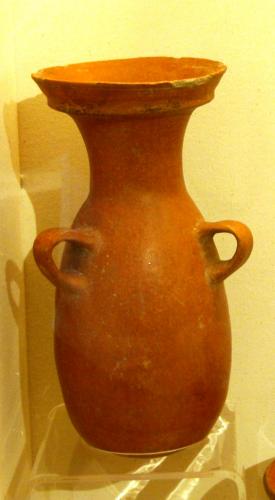San Andres Red
San Andrés Red is a versatile type that occurs in several important vessel types, including comales, ollas, and cazuelas. It is predominantly a utilitarian ware, characterized by relatively thick vessel walls and a reddish slip.
Paste and Firing Effects
The paste has a medium to coarse texture with a high proportion of medium to large inclusions as temper, giving eroded surfaces a sandy texture similar to Cerro Zapotecas Sandy Plain. The paste is tan to light reddish-brown, but often has a dark gray firing core, particularly in thicker pieces. Fire clouds are fairly common, but are often obscured by fire-blackening from use over a fire.
Surface Treatment
Vessel walls are smoothed to slightly burnished, and the surface often has scratches and irregular lumps in the finish. The diagnostic trait of the type is a thin reddish-orange slip that often appears "crackled." The interiors of globular ollas are usually unfinished. Cazuelas are finished on both the interior and exterior, although the exterior is usually more irregular. The upper, interior surface of comales is usually smoothed, while the exterior has the coarse texture typical of comal bases.
Decoration
San Andrés Red is undecorated other than the reddish slip that ranges in color from reddish-orange to reddish-brown. A possible subtype, Dark Red, was identified that has a dark red slip on thin-wall, well-fired comales that resemble Momoxpan Orange comales in form.
Vessel Forms
San Andrés Red is found in a variety of utilitarian ware vessel forms associated with food preparation and storage (Table 6). The most common vessel types include comales, ollas, cazuelas, and macetas.
Comales measure about 35 to 50 cm in diameter, with thick rims and relatively thick vessel walls. The interior, upper surface is lightly burnished and has the characteristic reddish slip, while the exterior, lower surface is unslipped and very rough. San Andrés Red comales are relatively thick in comparison to Momoxpan Orange comales, but are quite similar in form to Xicalli Plain comales. The Dark Red subtype was only identified in comales, and these were distinctive in their relatively thin rims and vessel walls, resembling Momoxpan Metallic Orange in general morphology.
Three main forms of olla are recognized on the basis of orifice size and shape, and each occurs in various specific rim forms. Long neck ollas (also known as cantaros) have constricted orifices, measuring between about 10 to 15 cm in diameter, with relatively long necks ranging from 2 to 6 cm in height (Fig. 1). Flattened spouts have been found suggesting that at least some of these may have functioned as pitchers. A common attribute of long-neck ollas is a flange, or ridge, around the neck 1 to 2 cm below the lip that may have been used to secure a cover on the vessel. Small mouth ollas also have constricted orifices, measuring 10 to 17 cm in diameter, but the neck is generally low, only about 1 to 3 cm in height. Wide mouth ollas have an orifice of about 22 to 26 cm, and a rim height of 2 to 5 cm. Handles are associated with all of these olla forms.

Figure 1: San Andres Red long neck olla
Cazuelas occur in two major forms: hemispherical cazuelas and conical cazuelas. Both are large vessels measuring about 25 to 35 cm in diameter, with a vessel height estimated at between 15 to 40 cm. Hemispherical cazuelas can be distinguished by their curving wall form, although they often have a composite silhouette with a 1 to 2 cm vertical rim before the curve begins. Conical cazuelas have a steeply sloping direct wall, often with a flattened rim. Small nub handles occur on cazuelas.
Macetas occurred in low frequencies in the total assemblage, but were more common in the Trash Midden deposit. These are often similar in form to cazuelas, but are even larger and heavier. They usually occur in either vertical wall or conical forms. Macetas have particularly thick vessel walls, and in some rim-to-base sherds the exterior base has a roughened surface similar to a comal.
Discussion
San Andrés Red is one of the most important and diverse utilitarian wares of the Postclassic Cholula ceramic complex, although variations in vessel form frequencies indicate that specific forms may have changed through time.
Noguera (1954:72) classified this as cerámica cafe claro ("light brown ceramic") on the basis of paste color, but more often identified it as simply "sin decoracion" ("undecorated"). Müller (1978:98-99, 111-112) identified red-slipped ollas, comales, cantaros, and cazuelas from the Postclassic period. These appear in her "Sin Engobe" ("without slip") class, despite the detailed description of their slip color.
The type was identified in early ceramic analyses from the Universidad de las Américas as "Huitzil Corrugado" (Peterson 1972) and "Fierro Monochrome modeled" (Mountjoy and Peterson 1973). These were relatively minor types in the assemblages, however, and consisted of only .5% (n=21) of the Faculty Housing midden deposit (Peterson 1972:200, Table 18).
In the UA-79 trash deposit (F-10), "San Andrés Red" made up 7.6% (n=311) of the assemblage, with "flanged jars" (long neck ollas), comales, and "basins" (cazuelas) as the most abundant vessel forms (Barrientos 1980).
At UA-1, San Andrés Red was present as 11.6% (n=1329) of the total assemblage. This frequency was fairly consistent between deposits, with the exception of Well 2 where San Andrés Red appeared as 29% (n=108) of the assemblage. This relatively high figure is in part due to the presence of the Dark Red subtype comales which may have replaced Momoxpan Orange to some extent in the Colonial period. San Andrés Red comales in general were more numerous in Wells 1 and 2, in relation to the Midden and Well 3 assemblages. Other vessel form frequencies remained fairly consistent.
San Andrés Red was not found in the R-106 subfloor deposits, and was present only as a trace at the Patio of the Carved Skulls (McCafferty 1996a). It is a useful diagnostic for the Postclassic complex, though it also continued into the Colonial period.

